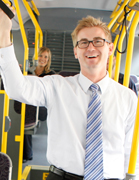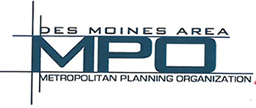Of all the things that go into creating a sustainable metropolitan area, this much we know: public transit is a vital ingredient.
Public transit makes it possible to get around for people without cars, whether they can’t drive for physical reasons, their age, or simply chose not to own a vehicle. And if more drivers choose to ride the bus, there are that many fewer cars on the roads – increasing capacity without having to build more new roadways. In addition, cities with reliable public transit are that much more affordable to live in, because you don’t have to rely on cars nearly as much.
That’s why it was so important for the Des Moines Area Regional Transit Authority (DART) to develop a vision for expanding public transit throughout Greater Des Moines. This vision, called the DART Forward 2035 Services Plan, calls for more service, to more places, at more times of the day, and with faster travel times.
Highlights of the DART Forward 2035 Services Plan include:
- More frequent service in urban core;
- Better commuter service, including more “reverse commutes” to take residents from downtown to suburban jobs;
- New circulator routes serving major suburbs;
- More Park and Rides;
- Extend the route of the D-Line Downtown Shuttle back up to the Capitol;
- New cross-town routes so people can travel from one side of the metro to the other without having to transfer downtown;
- Additional transfer locations to give people more options for making their trips by bus.
The DART Forward 2035 Services Plan is ambitious, but it has years of momentum behind it. In 2004, the Iowa Legislature passed legislation allowing for the creation of regional transit authorities. Then in 2006, regional leaders created DART out of the former Metropolitan Transit Authority (MTA). All along, the goal has been to build a truly regional transit system.
The DART Commission adopted the DART Forward 2035 Services Plan in September 2011, after more than a year of study by DART staff and outside transit experts. Now with a “blueprint” in hand, DART will begin implementing the service improvements in 2012, with a 13 percent expansion of service in the first year alone.
This year will also see the completion of DART Central Station, a new transit center in downtown Des Moines that will replace the aging and dated Walnut Street Transit Mall. The new station will feature indoor waiting areas, a customer service desk, public restrooms, bicycle storage, a café or coffee shop, public meeting rooms, 15 bus bays with canopies covering all walkways, and more.
Last but not least, DART is soon to launch a new online trip planner. Planning a trip by bus will be as simple as going to DART’s website and entering your origin and destination; the trip planner will automatically give you directions to take the trip by bus. In addition, DART is implementing GPS technology on its fleet of buses, meaning customers will not only be able to plan their trips online, they’ll be able to see precisely when the next bus will be to their stop.
In short, the transit system of Greater Des Moines’ future is rapidly taking shape. We hope all of our loyal DART riders like the changes they see. If you’re not already using the transit system, we hope you will take another look at riding the new and improved DART.
 Gunnar Olson is the Public Information Officer at DART. He can be reached at golson@ridedart.com.
Gunnar Olson is the Public Information Officer at DART. He can be reached at golson@ridedart.com.




13% is nothing–not to mention the city of Des Moines charges far too much for bus fare with transfers that are essentially worthless.
I await to see what this is going to amount to; however, given the parent company of DART…this will likely become a joke. From what I’ve seen in Des Moines in the past year of living here–only homeless people, poorly raised adolescents, and drunks use the bus system.
When it comes to the cities I’ve lived in (Milwaukee, San Francisco, Madison, Chicago, Washington DC, Boston) Des Moines has the worst mass transit system. Whoever thought of the current routes (which literally go nowhere) ought to be shot. Also, the “Walnut Street Transit Mall” is disgusting. No wonder all the shopping businesses in downtown Des Moines fled. Granted Des Moines’ downtown itself is very sad (worst than Milwaukee’s, which is saying something). It’s pretty bad when the 2nd tallest building in the city is just rust, and there are more (overpriced) parking garages in downtown than there are business buildings.
I love this town, but downtown and the mass transit systems are just terrible.
Hmm, buses that don’t run after 5 p.m. on Saturday… Pathetic.
Heck, Waterloo, Iowa has a better mass transit system and they are a quarter of Des Moines’ size. Sickening.
I grew up here, and I am all too familiar with the excitement and freedom a car was going to guarantee, plus who wants to ride the bus with the homeless and the drunks? Now, I have moved back here, after spending a good bit of time in Chicago. I lived there without a car for five years, and now I’m convinced that Des Moines can never be a world-class city until we have a good public transportation system.
I am excited to hear about the trip planner, but I honestly don’t understand this centralized system. Why don’t we have a grid? I can work out transfers, provided they’re offered. Why not offer a series of East-West buses and a series of essentially North-South buses?
Also, I hope that they consider signage at bus stops that gives information. Chicago’s bus stop signs showed which buses stopped there, along with an outline of the route, the times the bus ran, and how often it ran. It was quite helpful.
Finally, I like going out on the weekend, and I love not having to think about whether or not I should be driving. I sincerely hope there are plans to get people to the East Village or Court Avenue, or anywhere people go on the weekend, at night, when they want to drink. Not worrying about parking or how whether I’ve had one too many is glorious, and I can’t wait for these changes to finally come about.
I greatly look forward to the day when I can easily and affordably get around Des Moines without a car.
As a visitor from Portland, which has one of the nation’s best transit systems and a vibrant urban core, I was baffled by my visit to Des Moines. Since the downtown seems completely deserted, even during business hours, I don’t understand why Des Moines would need mass transit – where are the riders? Also,whether it was the result of unrestrained private initiative or poor planning, Des Moines has more parking structures than any city I have ever visited. How is that going to incent mass transit usage?
I think downtown Des Moines is hopeless except as a place for worker bees (not shoppers or other sorts of people) and for small-town executives who look at their high rise towers and event facilities and congratulate themselves on having such a happening city.